Reproduction in biology is defined as the process of producing offspring of the same kind. It ensures the continuity of life forms from generation to generation. It is the essential feature of every living organism; including all the microscopic organisms to multicellular plants and animals. Based on the number of parents required and the fusion of gametes, reproduction can be classified into two types as; sexual reproduction and asexual reproduction.
What is Sexual Reproduction?
Sexual reproduction is the type of reproduction where offspring are produced from the fusion of male and female gametes. It is a biparental reproduction process where gametes from a male (sperm) and female (ovum) fuse, forming a diploid zygote that will eventually develop into a new individual. Hence, the offspring will have combined genetic information from both parents of the opposite gender. However, there are some organisms where a single individual produces both male and female gametes, called hermaphrodites, and the sexual reproduction process is called hermaphroditism.
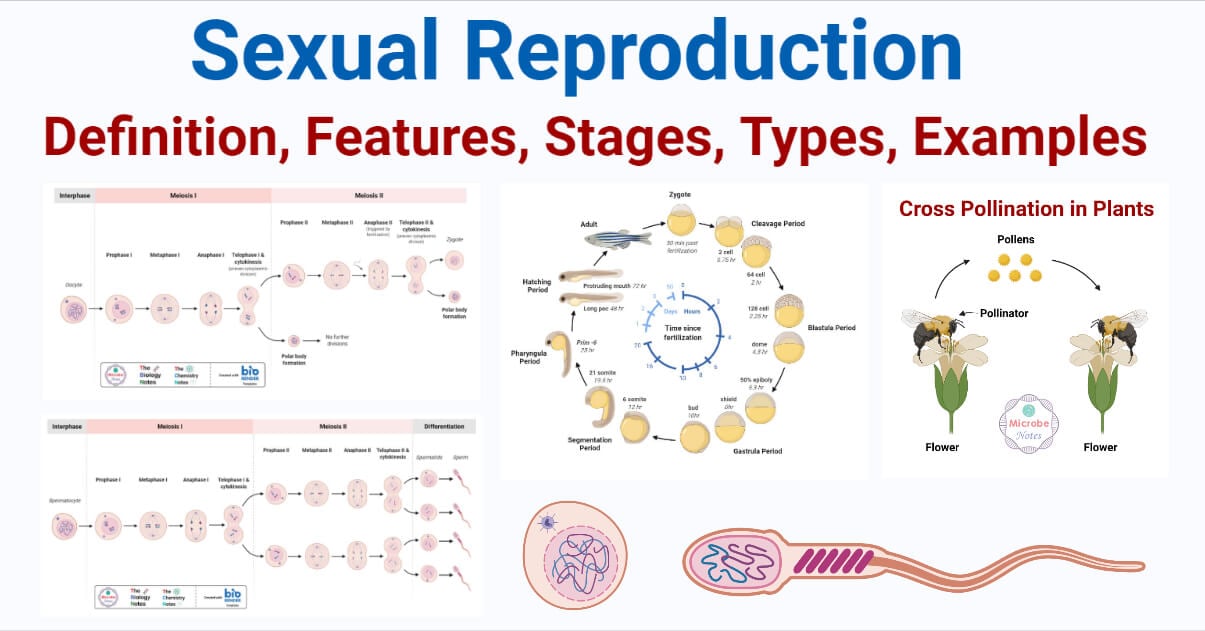
It is the most developed reproduction process occurring in all multicellular organisms. Most of the higher animals (except a few invertebrates and vertebrates) follow this process. However, some microorganism also shows sexual reproduction, which is called conjugation.
Sexual Reproduction Features
- There is formation and fusion of male and female gametes.
- Both male and female parents are required. (Hermaphrodites have both male and female gonads in a single body; hence a single parent can also take part in sexual reproduction.)
- The offspring produced will contain half genetic materials (DNA) from the mother, and the other half from the father. Hence, offspring are genetically different from their parents, and each other.
- Crossing over occurs during gametogenesis, and the offspring contain DNA from both parents. This leads to variation and in long term, the evolutionary change leads to the evolution of new species.
- The generation time is usually long, with a very long gestation period in higher animals and plants.
- There need to be gametogenesis, fertilization, and the development of the zygote and embryo. Hence, there is a huge expense of cellular energy.
- Offspring mature slowly so the population growth rate is comparatively slower.
- It is mainly seen in multicellular organisms, especially in higher plants and animals. Humans reproduce by this process only.
- Environmental factors have a comparatively lower influence than in asexual reproduction.
Stages of Sexual Reproduction
The sexual reproduction process can be divided into three basic stages, viz.:
1. Gametogenesis (Pre-fertilization stage)
This stage involves the formation of gametes (gametogenesis) and the transfer of the gametes. Mature male parents produce male gametes (sperms) in male gonads in a process called spermatogenesis. Mature female parents produce female gametes (ova) in female gonads in a process called oogenesis. Gametes are produced from meiotic cell division; hence each gamete produced will be a haploid.
In most cases, male gametes are mobile and female gametes are immobile. Hence, for fertilization, there must be the transfer of the male gametes up to female gametes. It occurs during pollination in plants or sexual intercourse process in higher animals or by environmental factors like water in lower plants and animals.
2. Fertilization
It is the process of fusion of haploid male and female gametes (i.e. ovum and sperm) leading to the formation of a diploid zygote. It is the crucial difference between sexual and asexual reproduction. The asexual reproduction process lacks the fertilization process. Fertilization together with the meiotic division during gametogenesis regulates the chromosome number in sexual reproduction.
Fertilization may occur outside the female body, called external fertilization. It is seen in fishes, some amphibians, crustaceans, echinoderms, algae, sponges, etc. It requires a water substrate for the transfer and fusion of gametes.
In most higher animals and plants, fertilization occurs inside the female body. This is called internal fertilization. It is seen in reptiles, some amphibians, insects, birds, mammals, higher plants, etc.
3. Embryogenesis and development (Post-fertilization)
It is the process of the development of the zygote and the formation of a new individual. The zygote divides mitotically forming the embryo in a process called embryogenesis. The embryo will then develop into a fetus where organogenesis occurs leading to the production of an infant. The infant will grow and mature to continue the reproduction process.
Sexual Reproduction Types
Broadly, sexual reproduction can be classified into two types; conjugation and syngamy.
1. Conjugation
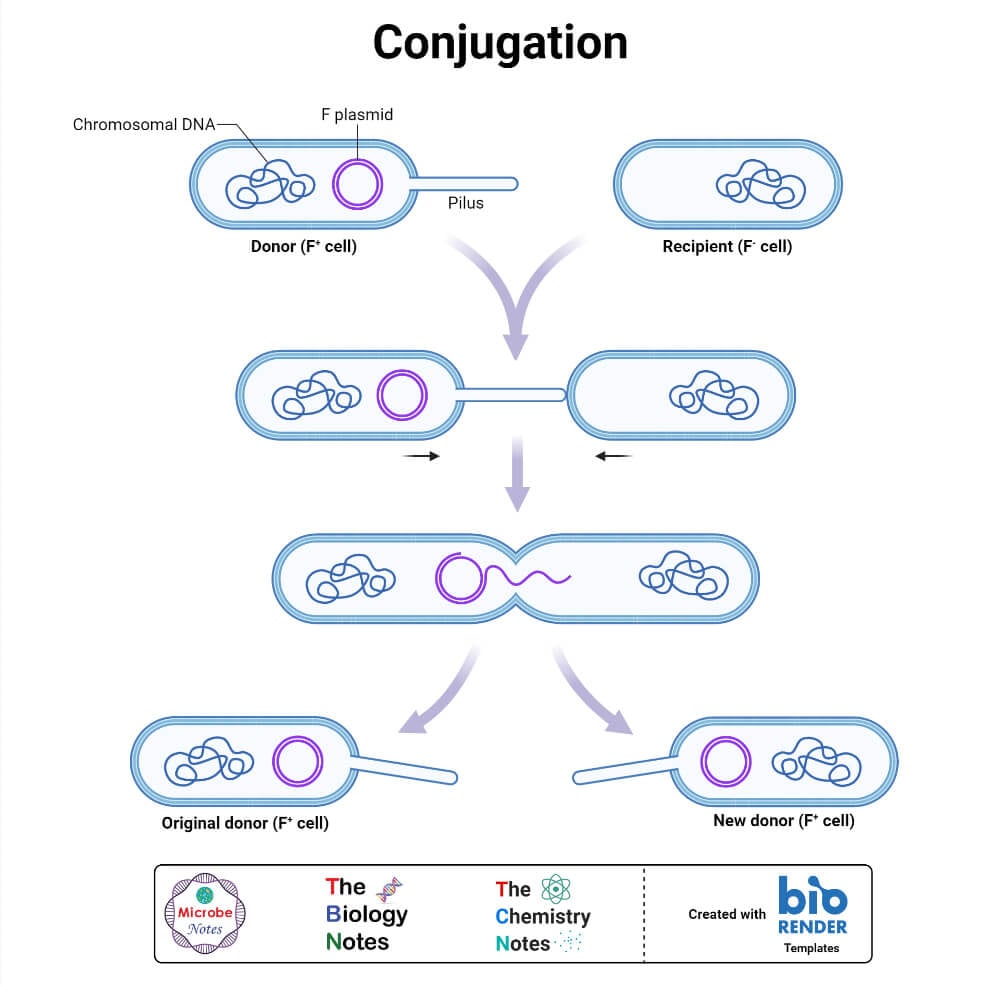
It is a type of sexual reproduction process where two individuals temporarily fuse and exchange their genetic materials through the pronuclei. It is seen in certain protozoa, algae, fungi, and bacteria. In the process, they either mutually exchange their genetic materials or completely transfer the genetic material of one to the other, or they both fuse together to form a zygote.
Instead of differentiating as male and female, the organisms are classified as mating types. They are differentiated as + and – mating types (mt (+) and mt (-).
2. Syngamy
It is the process of complete and permanent fusion of haploid male and female gametes to form a diploid zygote. It is also known as amphigony. Simply, sexual reproduction is understood as syngamy. It occurs in multicellular organisms.
Based on the number of parents involved (or the source of gametes), syngamy is of two types:
a. Exogamy (Cross-fertilization or Allogamy)
It is a biparental system where two different parents of opposite gender are involved in the process of sexual reproduction. The male parent (father) produces sperm, while the female parent (mother) produces the ovum. The two gametes produced by different individuals fuse in the fertilization process. Hence, the fertilization process is called cross-fertilization.
It is the most common type of sexual reproduction and is seen in mammals, birds, amphibians, reptiles, plants, etc. The individual involved in the process is called dioecious individuals.
The gametes are transferred during copulation or pollination in the internal fertilization process, and by water in the external fertilization process.
In plants, it is called allogamy. Allogamy is defined as the fertilization of the ovum produced by one individual with sperm produced by the next individual. In plants, the fusion of sperm and ovum produced by a separate flower on a separate plant is called allogamy.
b. Endogamy (Self-fertilization or Autogamy)
It is a type of syngamy where male and female gametes are produced by a single individual fuse to form a zygote. Such individuals are called monoecious or hermaphrodite, and the reproduction process is also called hermaphroditism. Hence, the fertilization process is called self-fertilization.
It is seen in a few lower invertebrates and some plants, such as earthworms, tapeworms, slugs, etc., and most of the flowering plants.
In plants, it is called autogamy. Autogamy is the self-fertilization process where the sperm and ovum produced in the same flower fuse together.
Based on the structure of gametes involved, syngamy is of two types:
a. Isogamy
It is a type of syngamy where the fusing gametes are morphologically similar to each other. The male and female gametes are morphologically identical and are called the isogametes. However, those isogametes can be differentiated based on their physiology. This makes organisms difficult to classify as male and female, so instead they are classified into two mating types; mt (+) and mt (-).
This form of syngamy is mainly seen in all unicellular eukaryotes, a few fungi, and algae; such as Spirogyra, Chlamydomonas, baker’s yeast, etc.
b. Anisogamy
It is a type of syngamy where the fusing of male and female gametes are of different shapes and sizes. These gametes can be morphologically differentiated. This leads to sexual dimorphism, and hence the parents are classified as male and female. It is seen in mammals, amphibians, reptiles, plants, birds, fungi, etc.
Male gametes are smaller and called microgametes or sperms. Female gametes are larger and called macrogametes or ova (eggs).
The sperm and ovum may be motile or non-motile. In most of the higher animals, an ovum is large non-motile while the sperm is small and motile. The fusion of such a non-motile ovum with a small motile is called oogamy. Mammals, birds, fishes, plants, etc., show oogamy.
There are other special modes of sexual reproduction, like:
- Hologamy; where the whole individual act as a gamete and fuses together. E.g. in Chlamydomonas, Rhizopoda, etc.
- Macrogamy; the fusion of two macrogametes. E.g. in Heliozoa
- Microgamy; the fusion of two microgametes. E.g. in Arcella and foraminers protozoa.
- Paedogamy; the fusion of two immature individuals acting as gametes that are produced by a single parent. E.g., in Actinosphaerium
- Cytogamy; the fusion of cytoplasm instead of nucleus. E.g., in Paramecium
- Automixis; autogamy where gametes produced by the division of a single nucleus fuse together.
- Neotony; production and fusion of gametes in the larval stage. For E.g. in axolotl larva
Sexual Reproduction in Plants
All the flowering plants have the capacity to sexually reproduce. A flower is the reproductive organ of plants that produce gametes. The androecium is the male reproductive part which contains the stamen where sperm is produced, while the gynoecium is the female reproductive part which contains the ovary where ova are produced.
Plants mostly follow anisogamy where both allogamy and autogamy are seen. In the unisexual flower, allogamy is only seen, while in the bisexual flower both allogamy and autogamy occur.
Most of the flowers contain both the androecium and gynoecium, so produce both the male and female gametes. Such flowers are called bisexual flowers. E.g. rose, sunflower, pea, orchid, rice, etc.
The flower which has either androecium or gynoecium only is called a unisexual flower. It is seen in some plants like papaya, watermelon, maize, coconut, cucumber, pumpkin, etc.
Sexual reproduction in plants can be described in three stages; gametogenesis, pollination, and fertilization.
1. Gametogenesis in Plants
It is the process of production of gametes. The androecium is the male reproductive part of the plants. It is divided into 3 parts; stamen, filament, and anther. The anther contains two chambers called microsporangia (pollen sac) inside which pollen grains are formed. The inner lining of microsporangia is made of pollen mother cells. These pollen mother cells divided meiotically to form haploid pollens. The pollen grain divides into two cells; the smaller generative cell, and the larger vegetative cell. The generative cell develops and divides into two microgametes (male gametes), and the vegetative cell forms a pollen tube. This process of formation of microgamete is called microsporogenesis.
The gynoecium is the female reproductive part of a plant. It contains three parts; stigma, style, and ovary. Inside the ovary, there are multiple lobes where ovules are present. Cells of the ovule develop and differentiate into the diploid megaspore mother cells. It divided meiotically into 4 haploid megaspores out of which 3 degenerates leaving one megaspore. The nucleus of the megaspore then meiotically divides to form 8 haploid nuclei, out of which six migrate to opposing poles (3 in each pole). The remaining two nuclei, called the polar nuclei, fuse to form the secondary nucleus. The 6 nuclei that have migrated towards the poles will form the embryo sac, and the secondary nucleus forms the female gamete nucleus. This entire structure is called the megaspore, and the process of formation is called megasporogenesis.
2. Pollination in Plants
The male gametes are produced in the anther of a stamen. The gametes are produced in the form of pollen grains. These pollen grains need to be transferred to the stigma of the pistil in the gynoecium of the same or different flower. This process is called pollination.
Based on the flowers among which the pollen grains are transferred, pollination is of two types:
- Self-pollination; the pollination process where the pollen produced by the anther of a flower is transferred to the stigma of the same flower is called self-pollination.
- Cross-pollination, the pollination process where the pollen produced by the anther of one flower is transferred to the stigma of another flower of the same or different plant, is called cross-pollination.
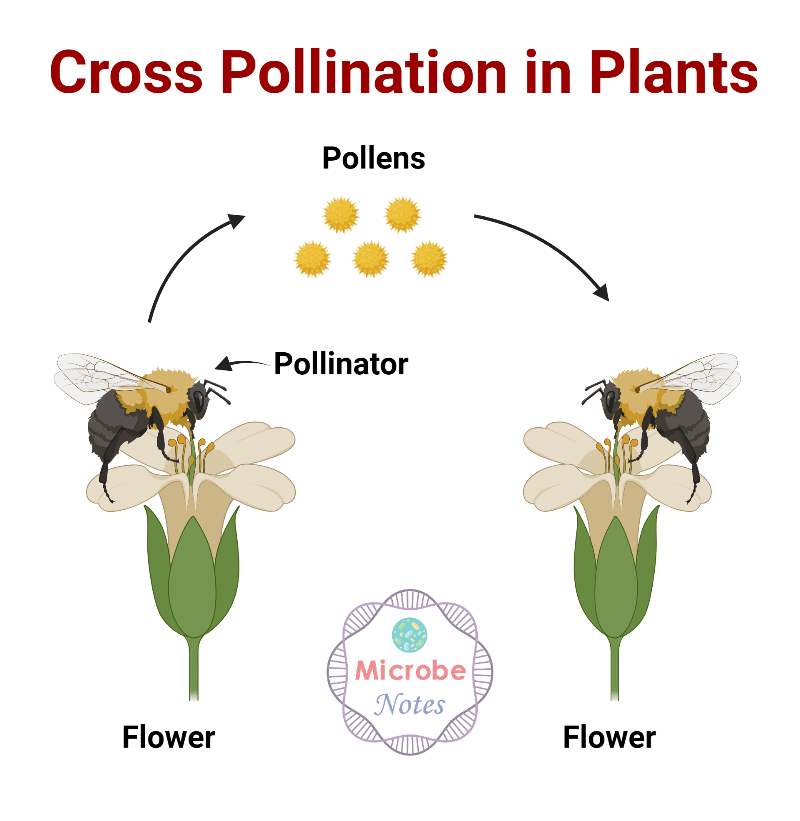
Pollination is facilitated by external agents called pollinators, like wind, insects, water, birds, animals, etc. After the pollination process, the pollens are converted to pollen tubes and transferred through the style to the ovary. At the ovary, male gametes are released from the pollen tubes and fertilize the ova.
3. Fertilization in Plants
It is the process of fusion of male gametes released from pollen grains with the ovum in the ovary of stigma to form a zygote. The zygote develops into a seed containing embryo and endosperm.
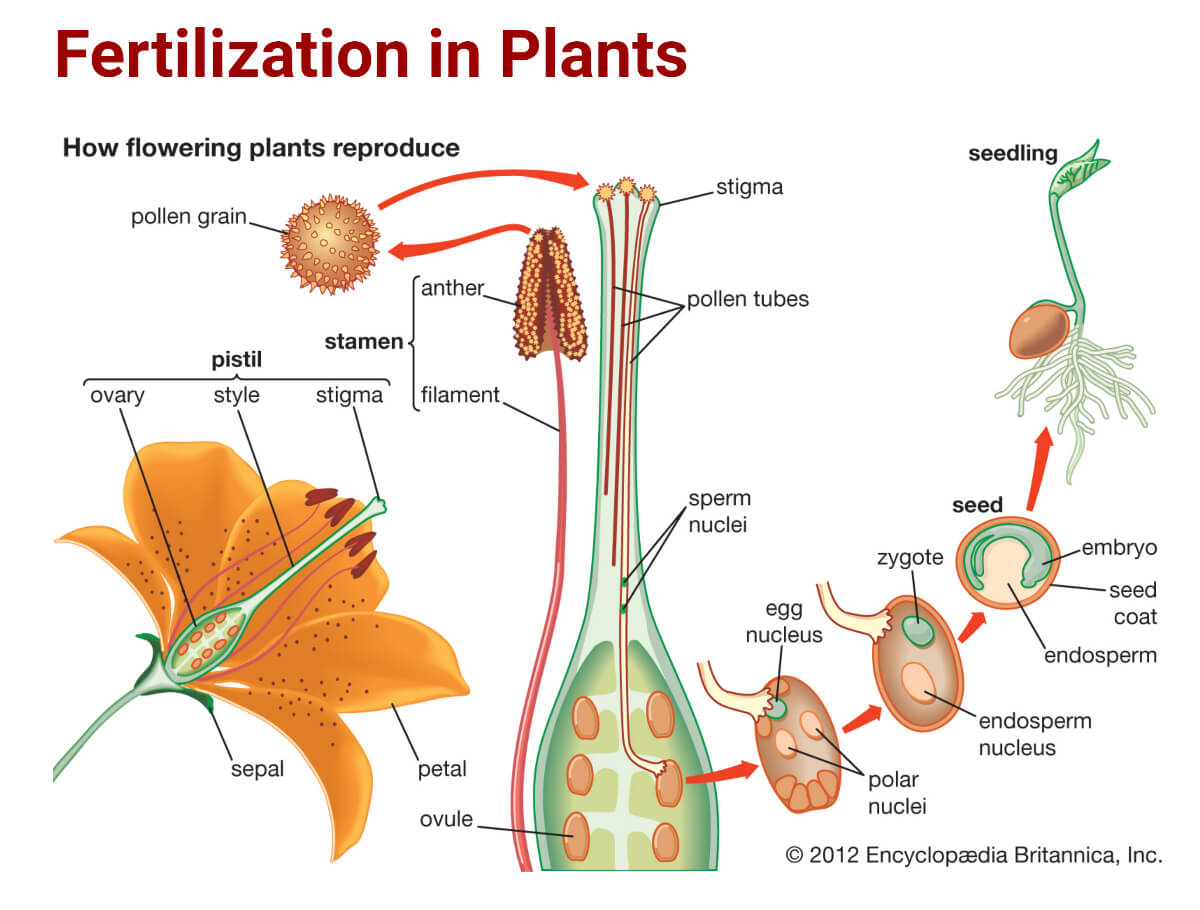
The wall of the zygote forms wall of the seed. The embryo is differentiated into the plumule, the radicle, and the cotyledon. The seed will be dispersed via different modes like insects, birds, animals, wind, water, etc. and under suitable environmental conditions, it germinates into a new baby plant.
Sexual Reproduction in Animals
Almost all animals have the capacity to reproduce sexually. Only a few animals, mainly lower invertebrates and a few vertebrates, reproduce asexually together with the asexual mode. Most multicellular animals show exogamy with anisogamous gametes. Most the unicellular animals follow conjugation as a sexual mode of reproduction.
For sexual reproduction, there must be a male-producing sperm (male gamete) and a female-producing ova/egg (female gamete). Most of the higher animals have distinct sexual dimorphism, but male and female of some invertebrates and some vertebrates look alike.
The process of sexual reproduction can be described in the following stages:
1. Gametogenesis in Animals
It is the process of production of gametes. The male gamete is called spermatozoa (sperm), and the female gamete is called the ova (egg).
Sperm are formed inside the testes, the male reproductive organ. Inside the testes is a coiled seminiferous tubule whose internal lining is of stem/germ cells (spermatogonia). These diploid spermatogonia undergo meiotic division to form 4 haploid spermatids. Each spermatid develops into a sperm. This process is called spermatogenesis.
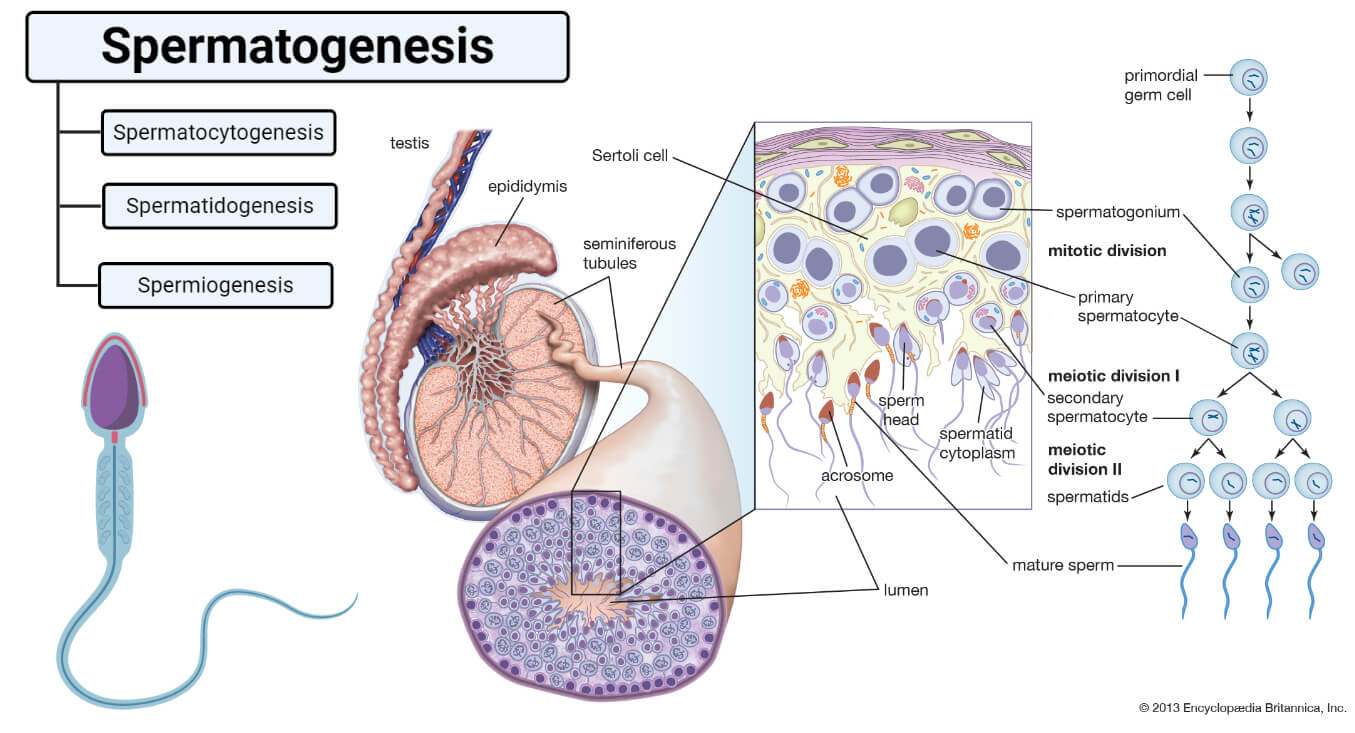
The egg or ova is formed inside the ovary, the female reproductive organ. The ovary contains diploid primary germ cells (oogonia) which will divide mitotically to form primary oocytes and increase their number. The primary oocyte undergoes 1st meiotic division resulting in one smaller haploid cell called the first polar body, and a larger haploid cell called the secondary oocyte. The first polar body generally degenerates and dies. The secondary oocyte further undergoes the 2nd meiotic division forming one smaller haploid cell called the second polar body, and a larger haploid cell called the ootid. The ootid matures and forms the ovum. This process is called oogenesis.
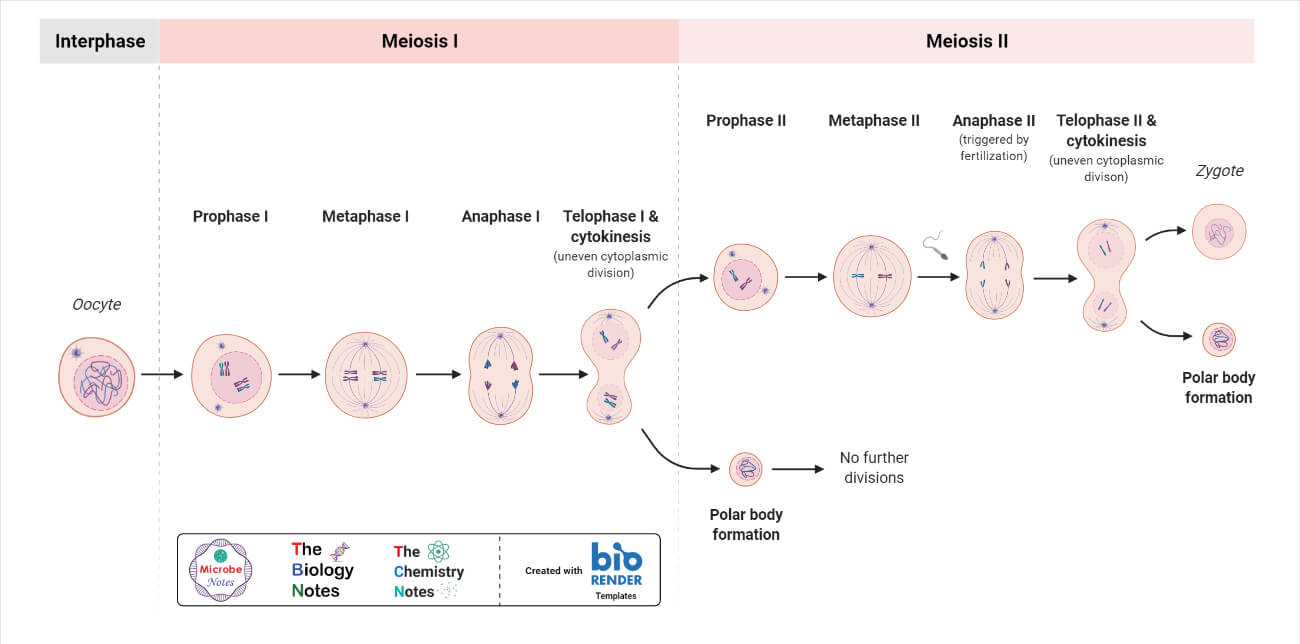
2. Fertilization in Animals
It is the fusion process of sperm and an ovum producing an embryo. In animals, fertilization may be internal or external.
Internal Fertilization
In this process, the fusion of sperm and ovum occurs inside the female’s body. Copulation occurs before the fertilization process. In copulation, male and female unite, and the male introduces sperm inside the female’s reproductive system. The sperm travel along the female reproductive tract and fuses with mature ovum, fertilizing them.
It is seen in viviparous, oviparous, and ovoviviparous animals, like mammals, sharks, birds, insects, etc.
External Fertilization
In this process, the fusion of sperm and ovum occurs outside the female’s body, i.e. in the external environment, mostly in water. Copulation does not occur in the process. It is seen in some oviparous animals like fishes, amphibians like frogs, toads, and a few insects.
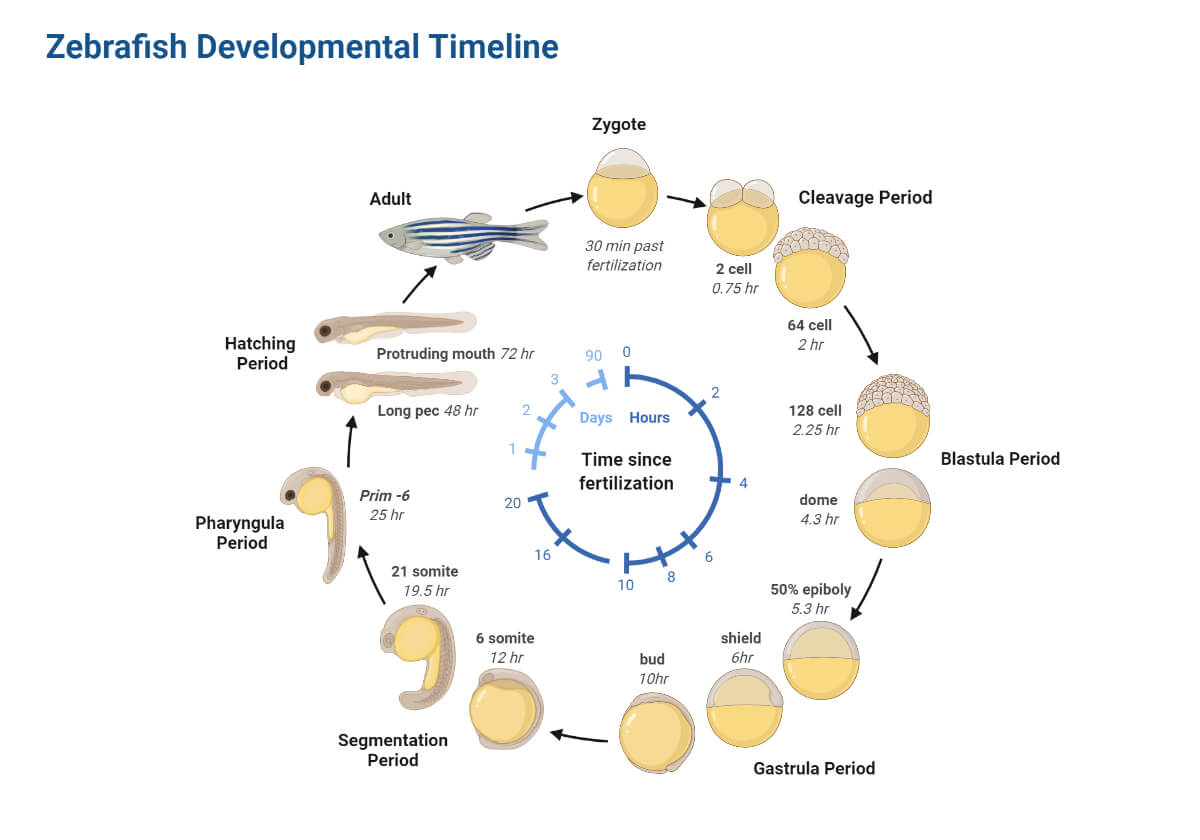
c. Hatching or Birth of Baby
Animals may directly give birth to a baby or may lay an egg that will later hatch releasing a baby. Based on this mode of reproduction (i.e., whether the development of the embryo and hatching of the young takes place internally or externally in the mother’s body) animals may be classified into; Oviparous, Viviparous, and Ovoviviparous animals, and the mode of reproduction into Oviparous, Viviparous and Ovoviviparous mode of reproduction accordingly.
- Oviparous Animals
Those animals which lay an egg containing undeveloped and immature embryos in the environment (i.e. outside the body) are called oviparous animals. In the external environment, the embryo develops further within the egg and the baby hatches out on maturation. This mode of reproduction is seen in all the invertebrates, fishes, amphibians, reptiles, and birds.
- Viviparous Animals
Those animals which directly give birth to a young baby are called viviparous animals. In this mode, the embryo develops inside the female’s (mother’s) reproductive system, mostly in the uterus, and develops into a fetus and a mature young baby. Then, the baby is given birth out in the environment. It is seen in all mammals.
- Ovoviviparous Animals
It is a special reproduction strategy in animals where eggs are laid, developed, and hatched, releasing young ones inside the mother’s body. Once hatched, the young babies are nourished inside the female body and given birth to babies when they mature.
Their difference from viviparous animals is that there is no umbilical cord and they are nourished with the yolk but not via the placental appendages.
It is seen in some sharks, snakes, amphibian toads, and salamanders.
Sexual Reproduction Advantages
- An essential advantage is sustaining the life form by continuing the generations.
- It allows for variation and adaptation. This will result in evolutionary changes leading to the origination of sub-species and even speciation, i.e. promoting genetic variations.
- Sexual reproduction produces offspring that are better suited to the changing environment. Hence, the newer generation will have a better adaptation to the changing environment than their parents.
- There is a 50% chance that the offspring won’t have the harmful trait present in their parents.
- The population growth rate is comparatively slower. This will reduce the problem of overpopulation size and intraspecific competition.
Sexual Reproduction Disadvantages
- The reproduction process is slow and requires lots of cellular energy during the process.
- The baby requires a longer period to be mature enough to reproduce and only a few offspring are produced; hence the population size will grow very slowly.
- There is the genetic variation; hence the important traits in parents might not pass on to offspring. Similarly, due to variation, some harmful traits may be seen in offspring.
- There is a need for both males and females. Hence, animals have to travel in search of mates. Higher animals must display courtship behavior and participate in copulation.
- Maturity and the whole reproduction cycle are affected by environmental stresses. So, there is no sexual reproduction in harsh environmental conditions, and usually, the embryo can’t develop.
References
- Reproduction Definition & Meaning – Merriam-Webster
- Biological reproduction | definition of Biological reproduction by Medical dictionary (thefreedictionary.com)
- Reproduction – definition of reproduction by The Free Dictionary
- Britannica, T. Editors of Encyclopaedia (2020, June 19). sexual reproduction. Encyclopedia Britannica. https://www.britannica.com/science/sexual-reproduction
- External Fertilization – Solved Examples, Features and Facts (vedantu.com)
- 3 Events Involved in Sexual Reproduction : Gametogenesis, Gamete Transfer and Fertilization (yourarticlelibrary.com)
- Internal Fertilization – Advantages and Important FAQs (vedantu.com)
- A Brief Account on Internal Fertilization (byjus.com)
- What is Zygote?- Definition, Formation, And Development Of Zygote (byjus.com)
- Sexual Reproduction: Definition, Stages, Process, Examples and Videos (toppr.com)
- Sexual Reproduction – An Overview, Stages and its Process (byjus.com)
- Syngamy – Definition, Types, Difference Between & Video (byjus.com)
- Isogamy – an overview | ScienceDirect Topics
- Anisogamy – an overview | ScienceDirect Topics
- Britannica, T. Editors of Encyclopaedia (2019, February 22). conjugation. Encyclopedia Britannica. https://www.britannica.com/science/conjugation-sexual-process
- Conjugation Definition and Examples – Biology Online Dictionary
- Reproduction in Protozoa | Microorganisms | Zoology (notesonzoology.com)
- Types of Sexual Reproduction | Important (gkscientist.com)
- Reproduction, Types of sexual reproduction (Conjugation, Reproduction by sexual gametes) | Science online (online-sciences.com)
- Sexual Reproduction in Plants – Process and Fertilization (vedantu.com)
- 40 – Sexual Reproduction in Plants (mrcbiology.com)
- Gametogenesis in Plants: Sporogenesis and Gametogenesis – Online Biology Notes
- Gametogenesis in Plants: Formation of Male & Female Gametes, Example (toppr.com)
- Sexual Reproduction in Plants- Features and its Process (byjus.com)
- What Are Oviparous Animals? – Definition And Examples (animalwised.com)
- What Are Ovoviviparous Animals? (thoughtco.com)
- Viviparous Animals – Examples and Characteristics (animalwised.com)
- Oviparous – Definition and Examples | Biology Dictionary
- Process of Gametogenesis in Animals (notesonzoology.com)
- 43.3C: Gametogenesis (Spermatogenesis and Oogenesis) – Biology LibreTexts
- An Overview On Viviparous, Oviparous & Development Of Embryo (byjus.com)
- Sexual Reproduction in Animals: Types, Examples and more ▷➡️ Postposmo | Postposm
- Sexual reproduction in animals – Online Science Notes
- 11 Advantages And Disadvantages Of Sexual Reproduction – Vittana.org
- Sexual Reproduction: Definition, Stages and Types (embibe.com)
- Sexual Reproduction – The Definitive Guide | Biology Dictionary
- Sexual and Asexual Reproduction – Introduction, Types and Process (vedantu.com)
